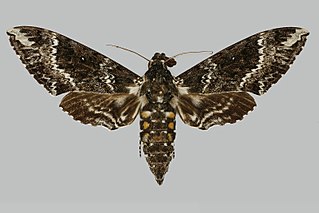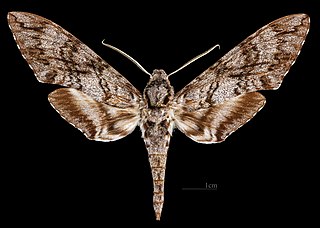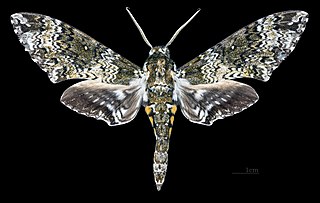
Manduca rustica, the rustic sphinx, is a moth of the family Sphingidae. The species was first described by Johan Christian Fabricius in 1775.

Manduca is a genus of moths in the family Sphingidae, the hawkmoths. The genus is used as a model in the biological sciences. The tobacco hornworm and the tomato hornworm in particular have been well studied. The genus was erected by Jacob Hübner in 1807.

Manduca corallina is a moth of the family Sphingidae first described by Herbert Druce in 1883.

Manduca andicola is a moth of the family Sphingidae first described by Walter Rothschild and Karl Jordan in 1916. It is found from Central America to Peru, Ecuador, Bolivia and Argentina.

Manduca boliviana is a moth of the family Sphingidae. It is known from Bolivia.

Manduca camposi is a moth of the family Sphingidae. It is known from Ecuador.

Manduca chinchilla is a moth of the family Sphingidae. It is known from Peru.

Manduca clarki is a moth of the family Sphingidae first described by Walter Rothschild and Karl Jordan in 1916. It is known from Brazil, Colombia, Ecuador, Peru and Bolivia.

Manduca corumbensis is a moth of the family Sphingidae.

Manduca dalica is a moth of the family Sphingidae.

Manduca diffissa is a moth of the family Sphingidae first described by Arthur Gardiner Butler in 1871. It is known from most of South America.

Manduca dilucida is a moth of the family Sphingidae first described by William Henry Edwards in 1887.

Manduca violaalba is a moth of the family Sphingidae first described by Benjamin Preston Clark in 1922.

Manduca manducoides is a moth of the family Sphingidae.

Manduca morelia is a moth of the family Sphingidae first described by Herbert Druce in 1884. It is known from Mexico.

Manduca mossi is a moth of the family Sphingidae. It is known from Peru, eastern Ecuador and Bolivia.

Manduca prestoni is a moth of the family Sphingidae. It is known from Brazil, Ecuador and Bolivia.

Manduca tucumana is a moth of the family Sphingidae.

Manduca sesquiplex is a moth of the family Sphingidae. It is known from Mexico, Costa Rica and Nicaragua.

Manduca scutata is a moth of the family Sphingidae.





















